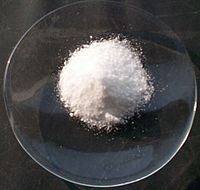ପୋଟାସିଅମ କ୍ଲୋରାଇଡ
Appearance

| |

| |
| Names | |
|---|---|
| Other names
Sylvite
Muriate of potash | |
| Identifiers | |
| CAS number | 7447-40-7 |
| PubChem | 4873 |
| ChemSpider | 4707 |
| UNII | 660YQ98I10 |
| KEGG | D02060 |
| ChEBI | CHEBI:32588 |
| ChEMBL | CHEMBL1200731 |
| RTECS number | TS8050000 |
| Jmol-3D images | Image 1 |
| |
| |
| Properties | |
| Molecular formula | KCl |
| Molar mass | 74.5513 g·mol−1 |
| Appearance | white crystalline solid |
| Odor | odorless |
| Density | 1.984 g/cm3 |
| Melting point | 770 °C (1,420 °F; 1,040 K) |
| Boiling point | 1,420 °C (2,590 °F; 1,690 K) |
| Solubility in water | 21.74% (0 °C) 25.39% (20 °C) 36.05% (100 °C) |
| Solubility | Soluble in glycerol, alkalies Slightly soluble in alcohol Insoluble in ether[୧] |
| Acidity (pKa) | ~7 |
| −39.0·10−6 cm3/mol | |
Refractive index (nD)
|
1.4902 (589 nm) |
| Structure | |
| face centered cubic | |
| Fm3m, No. 225 | |
a = 629.2 pm [୨]
| |
| Octahedral (K+) Octahedral (Cl−) | |
| Thermochemistry | |
Std molar
entropy (S |
83 J·mol−1·K−1[୩] |
Std enthalpy of
formation (ΔfH |
−436 kJ·mol−1[୩] |
| Pharmacology | |
| A12BA01 (WHO) B05XA01 | |
| |
| Oral, IV, IM | |
| Pharmacokinetics: | |
| Renal: 90%; Fecal: 10% [୪] | |
| Hazards | |
| NFPA 704 | |
| Flash point | |
| Lethal dose or concentration (LD, LC): | |
| Related compounds | |
Other anions
|
Potassium fluoride Potassium bromide Potassium iodide Potassium astatide |
Other cations
|
Lithium chloride Sodium chloride Rubidium chloride Caesium chloride Francium chloride |
Related compounds
|
Potassium chlorate Potassium perchlorate |
| Except where noted otherwise, data are given for materials in their standard state (at 25 °C (77 °F), 100 kPa) | |
| | |
| Infobox references | |
|
| |
ଆଧାର
[ସମ୍ପାଦନା]- ↑ "Potassium chloride (PIM 430)". International Programme on Chemical Safety. 3.3.1 Properties of the substance. Retrieved 2011-01-17.
- ↑ D.B. Sirdeshmukh; L. Sirdeshmukh; K.G. Subhadra. Alkali Halides: A Handbook of Physical Properties.
- ↑ ୩.୦ ୩.୧ Zumdahl, Steven S. (2009). Chemical Principles 6th Ed. Houghton Mifflin Company. p. A22. ISBN 0-618-94690-X.
- ↑ "Compound Summary for CID 4873". Retrieved 17 October 2015.
- ↑ http://chem.sis.nlm.nih.gov/chemidplus/rn/7447-40-7[full citation needed]

